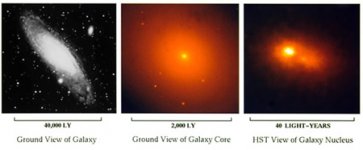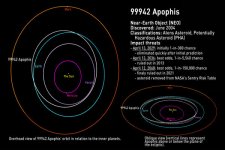Hubble has just captured an image of a flaming blue sword situated some 1,300 light years from Earth!
A young star is blasting superheated jets from its poles through surrounding clouds of dust and gas.
The dramatic interaction between jets and clouds forms an uncommon sight known as a Herbig-Haro object.
This one is number HH111.
A young star is blasting superheated jets from its poles through surrounding clouds of dust and gas.
The dramatic interaction between jets and clouds forms an uncommon sight known as a Herbig-Haro object.
This one is number HH111.
Attachments
Galu would never break the rules by writing in a language other than English of course. 😀Correct!
Mutyi – Wikipedia
In today's Hungarian language, mutyi means a secret agreement, the aim of which is to gain a common profit or benefit by excluding others from the information.
So it is the meaning of mutyiverse.
I speak in the Scots dialect every Burns Night!
Fair fa’ your honest, sonsie face,
Great Chieftain o’ the Puddin-race!
Aboon them a’ ye tak your place,
Painch, tripe, or thairm:
Weel are ye wordy of a grace
As lang‘s my arm.
And the rules of the forum are that I must give a translation!
Good luck to you and your honest, plump face,
Great Chieftain of the sausage race!
Above them all you take your place,
Stomach, tripe, or intestines:
Well are you worthy of a grace
As long as my arm.
😀
Fair fa’ your honest, sonsie face,
Great Chieftain o’ the Puddin-race!
Aboon them a’ ye tak your place,
Painch, tripe, or thairm:
Weel are ye wordy of a grace
As lang‘s my arm.
And the rules of the forum are that I must give a translation!
Good luck to you and your honest, plump face,
Great Chieftain of the sausage race!
Above them all you take your place,
Stomach, tripe, or intestines:
Well are you worthy of a grace
As long as my arm.
😀
Attachments
Hubble has just captured an image of a flaming blue sword situated some 1,300 light years from Earth!
A young star is blasting superheated jets from its poles through surrounding clouds of dust and gas.
The dramatic interaction between jets and clouds forms an uncommon sight known as a Herbig-Haro object.
This one is number HH111.
Wow - an incredible photo!!
HH 111 - Wikipedia
The jets are c. 2.6 light years long
Last edited:
The dramatic interaction between jets and clouds forms an uncommon sight known as a Herbig-Haro object.
This one is number HH111.[/QUOTE]
Is the light illuminated plasma jetting, or a huge gas cloud being lit up by a light ray?
This one is number HH111.[/QUOTE]
Is the light illuminated plasma jetting, or a huge gas cloud being lit up by a light ray?
As far as I understand it, it’s a bit of both, but mainly matter jetting outwards. You get a similar effect with black holes at the centre of galaxies. In this case the star is rotating, gas falling into the star. Very strong magnetic fields focus the jets out of either pole. The gas particles are moving at 500-600 km/sec and illuminated by friction within the jet, the host star, and any surrounding gas that may be present that they collide with.
That's a good explanation, Bonsai. 😎
I'm finding the Cosmos site very useful in giving concise descriptions of complex cosmological phenomena.
Stellar Jets | COSMOS
I'm finding the Cosmos site very useful in giving concise descriptions of complex cosmological phenomena.
Stellar Jets | COSMOS
Interestingly, the rate of in-fall of material is not smooth and this results in the production of 'bullets' of denser material in the jets. The Cosmos link includes a time-lapse movie of HH30 which shows these 'bullets'."As material falls onto the protostar from the surrounding accretion disk, it is thought that interactions between the magnetic fields of the rotating star and the accretion disk turn the in-falling material around and eject it from the stellar magnetic poles. This is what we observe as stellar jets."
Here’s more on jets - this time from a super massive black hole (SMBH)
Event Horizon Telescope snaps close-up of supermassive black hole jets
The jets in this case are longer than the diameter of the host galaxy - so 10’s of thousands of LY.
Event Horizon Telescope snaps close-up of supermassive black hole jets
The jets in this case are longer than the diameter of the host galaxy - so 10’s of thousands of LY.
Nice! 😎
Centaurus A is an active galaxy, firing off gigantic jets of material from its central black hole.
However, there's more to the story - Centauras A is a cannibal galaxy! 😱
In the attached image, taken by the Spitzer Space Telescope, the remnants of a devoured galaxy form the dark disk at right angles to the plane of the jets.
Weird Object: Centaurus A | Astronomy.com
Centaurus A is an active galaxy, firing off gigantic jets of material from its central black hole.
However, there's more to the story - Centauras A is a cannibal galaxy! 😱
In the attached image, taken by the Spitzer Space Telescope, the remnants of a devoured galaxy form the dark disk at right angles to the plane of the jets.
Weird Object: Centaurus A | Astronomy.com
Attachments
Watch out! Our nearest galactic neighbour, the Andromeda galaxy, is also a cannibal. 😱
Observations show its nucleus to have two supermassive black holes circling each other. It is believed that this is the result of Andromeda ‘devouring’ another galaxy which also contained a supermassive black hole.
Zooming into the centre of Andromeda (see attached images) reveals two bright spots, each thought to be a densely packed swarm of stars around a supermassive black hole. The brighter spot is thought to be the nucleus of the galaxy swallowed by Andromeda because the true centre of the Andromeda galaxy coincides with the dimmer spot.
Galactic Nuclei | COSMOS
Observations show its nucleus to have two supermassive black holes circling each other. It is believed that this is the result of Andromeda ‘devouring’ another galaxy which also contained a supermassive black hole.
Zooming into the centre of Andromeda (see attached images) reveals two bright spots, each thought to be a densely packed swarm of stars around a supermassive black hole. The brighter spot is thought to be the nucleus of the galaxy swallowed by Andromeda because the true centre of the Andromeda galaxy coincides with the dimmer spot.
Galactic Nuclei | COSMOS
Attachments
Last edited:
Nice! 😎
Centaurus A is an active galaxy, firing off gigantic jets of material from its central black hole.
However, there's more to the story - Centauras A is a cannibal galaxy! 😱
In the attached image, taken by the Spitzer Space Telescope, the remnants of a devoured galaxy form the dark disk at right angles to the plane of the jets.
Weird Object: Centaurus A | Astronomy.com
You can see from that image that the whole galaxy is also rotating about the horizontal axis (as well as the normal polar axis) - hence the shape of the jets. If we were looking at it a further 90 degrees either way, the top and bottom jets would appear to emerge from the plane like an integral sign - (Steve will like that 😉 ) a sure indication that its collided/merged with another galaxy.
Interestingly (I've said this before), Andromeda, despite being almost 2x the size of the Milky Way, is not as heavy. Its also 3-4 billion yrs younger. There's a lot more dark matter within the Milky Way.
Integral sign is a good description, and hysteresis loop is another.You can see from that image that the whole galaxy is also rotating about the horizontal axis (as well as the normal polar axis)...the top and bottom jets would appear to emerge from the plane like an integral sign.
The motions of the stars in Centaurus A have been mapped and there is indeed a stellar component rotating rather slowly around an axis which is only roughly perpendicular to the dust disc.
The dust disc is probably the mangled remains of a spiral galaxy in the process of being ripped apart by the gravitational pull of the giant elliptical galaxy.
The Cartwheel galaxy was similar to our own Milky Way galaxy until quite recently, when a smaller galaxy ploughed through its centre.
Interactions like this are often referred to as galaxy "harassment"!
This harassment caused a wave of new star formation which moved out from the impact point like a ripple across the surface of a pond.
This has resulted in the bright blue wheel and spokes which give the galaxy its name.
Interactions like this are often referred to as galaxy "harassment"!
This harassment caused a wave of new star formation which moved out from the impact point like a ripple across the surface of a pond.
This has resulted in the bright blue wheel and spokes which give the galaxy its name.
Attachments
I am pretty sure I saw Venus after sunset a couple of months back. But it has proved elusive ever since... 😕
Reason is it is only 8 degrees above the setting sun. Even in December it will only be 14 degrees high at sunset.
When Is The ‘Harvest Moon?’ Your Stargazing Guide To September 2021
Thursday Sept 9 is our best chance to see it. Near the new moon and Spica in Virgo. 🙂
A fascinating asteroid, 2021 PH27, has been discovered by the Dark Matter survey in Chile.
Fastest-orbiting asteroid in solar system discovered | Space
The second fastest known solar orbit after Mercury at 113 days. Precesses 360 degrees every 20,000 years according to my back of a beermat General Relativity calculation. 😎
Have decided it is bunk to think anti-matter is repelled by Gravity. Have devised an experiment with positronium (decaying to two 511KeV photons) and a Schrodinger Cat that proves this.
Photon - Wikipedia
Reason is it is only 8 degrees above the setting sun. Even in December it will only be 14 degrees high at sunset.
When Is The ‘Harvest Moon?’ Your Stargazing Guide To September 2021
Thursday Sept 9 is our best chance to see it. Near the new moon and Spica in Virgo. 🙂
A fascinating asteroid, 2021 PH27, has been discovered by the Dark Matter survey in Chile.
Fastest-orbiting asteroid in solar system discovered | Space
The second fastest known solar orbit after Mercury at 113 days. Precesses 360 degrees every 20,000 years according to my back of a beermat General Relativity calculation. 😎
Have decided it is bunk to think anti-matter is repelled by Gravity. Have devised an experiment with positronium (decaying to two 511KeV photons) and a Schrodinger Cat that proves this.
Photon - Wikipedia
I saw an incredibly bright Jupiter high in the sky to the south-east last Saturday (28th August).
It was shining in solitary splendour just before the stars had appeared.
It was so bright and obviously disc shaped that I fetched my visiting son out of the house to have a look.
Apparently, Jupiter reached opposition on the 19th of August.
Jupiter is at its biggest and brightest this week | Space
It was shining in solitary splendour just before the stars had appeared.
It was so bright and obviously disc shaped that I fetched my visiting son out of the house to have a look.
Apparently, Jupiter reached opposition on the 19th of August.
Jupiter is at its biggest and brightest this week | Space
Record-breaking 2021 PH27 has been nicknamed the Usain Bolt of asteroids!A fascinating asteroid, 2021 PH27, has been discovered by the Dark Matter survey in Chile.
Precesses 360 degrees every 20,000 years according to my back of a beermat General Relativity calculation. 😎
Fastest-orbiting asteroid in solar system discovered | Space
The precession in its orbit is shown in the attached Wiki image.
Thankfully, 2021 PH27 will never intersect with the Earth's orbit as shown in the attached artist's impression! 😱
Attachments
I do worry about Asteroids...
Apparently there are ones that get even closer to the Sun than 2021 PH27.
Phaethon is one:
Geminid meteor shower's 'fizzing' asteroid acts like a comet - CNN
The strange blue 3 mile wide source of the Geminid meteor shower. On track for a space mission soon. 2025?
But the real monster is called Apophis. This 300m rock was considered likely to directly hit us!
99942 Apophis - Wikipedia
Friday 13th. April 2029! Happily it misses by a mere 16,000 miles according to more refined calculations. I hope they are better than me at maths. 😱
Apparently there are ones that get even closer to the Sun than 2021 PH27.
Phaethon is one:
Geminid meteor shower's 'fizzing' asteroid acts like a comet - CNN
The strange blue 3 mile wide source of the Geminid meteor shower. On track for a space mission soon. 2025?
But the real monster is called Apophis. This 300m rock was considered likely to directly hit us!
99942 Apophis - Wikipedia
Friday 13th. April 2029! Happily it misses by a mere 16,000 miles according to more refined calculations. I hope they are better than me at maths. 😱
99942 Apophis - Wikipedia
Happily it misses by a mere 16,000 miles according to more refined calculations. I hope they are better than me at maths. 😱
That would mean the asteroid coming well within geosynchronous orbit which is at an altitude of 22,000 miles! 😱
P.S. Apophis has been removed from NASA's Sentry Risk Table in 2021 - phew!
Attachments
- Status
- Not open for further replies.
- Home
- Member Areas
- The Lounge
- What is the Universe expanding into..







